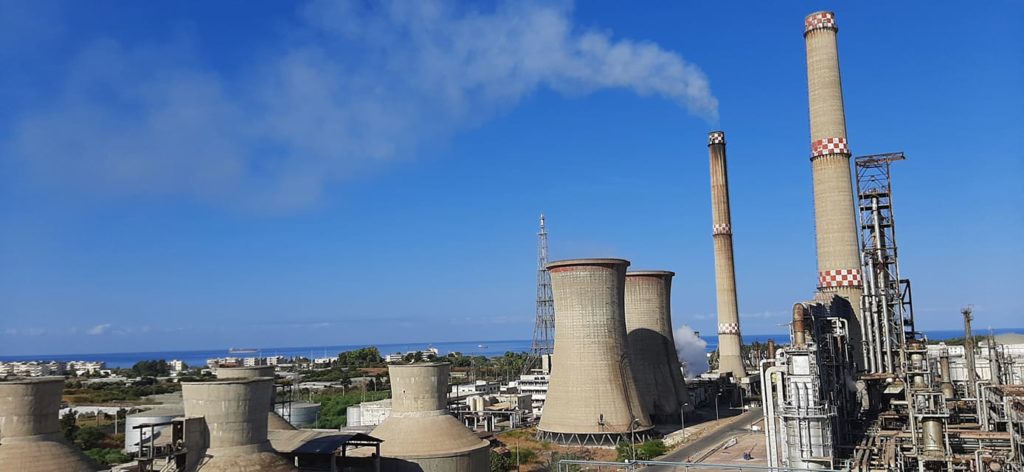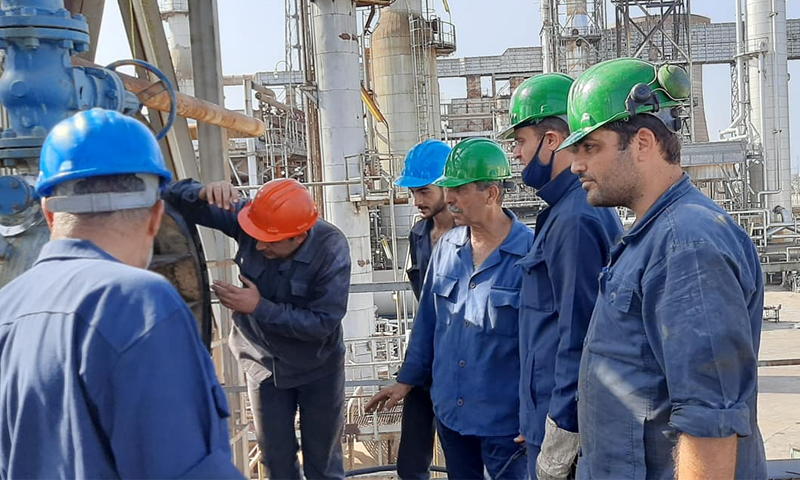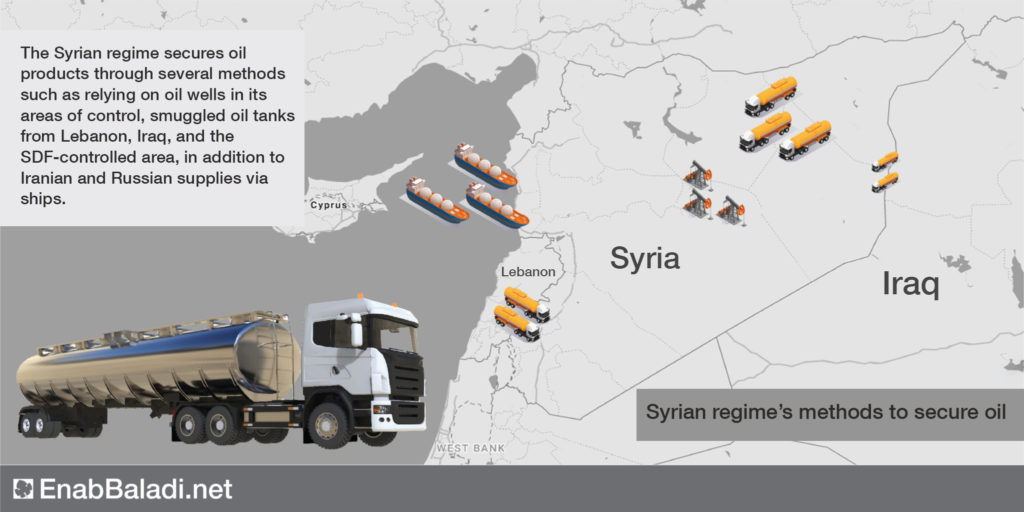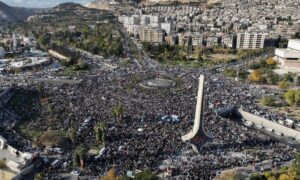Ali Darwish- Nour al-Deen Ramadan- Khawla Hefzy- Saleh Malas
Along with the continuous intensification of battles on various Syrian lands since 2012 between the Syrian regime forces with its allied militias on one side and the opposition factions on the other, the regime’s control has decreased in northeastern Syria, where more than 80% of the country’s energy sources are located.
These battles have rendered the oil wells and facilities out of service. Frequent changes took place in the controlling parties of the areas where these facilities and wells are located; factions of the local opposition forces, the so-called Islamic State (IS), and lastly, the “Syrian Democratic Forces” (SDF/QSD) controlled these areas consecutively, especially north-eastern Syria and the eastern Homs countryside.
However, the Syrian regime could not establish its control over the region containing the majority of the oil and gas wells during these years, which was detrimental to the economy and turned Syria from a country that exported about 200 thousand oil barrels per day an oil-importing country.
There is a current shortage of petroleum products in the Syrian regime-controlled areas, crowned with the gasoline crisis, which the regime intends to solve by the end of the Banias refinery’s maintenance work.
However, a shortage of petroleum products has been a crisis suffered by people in the government-held area for years, amid unfulfilled promises to solve the fuel crisis by their authorities that blamed the sanctions. Besides, the regime-supporting countries attempt to supply it with oil and circumvent the imposed sanctions.
In this file, Enab Baladi discusses the Syrian regime’s methods to obtain oil, its management mechanism of the oil sector, the impact of fuel shortage on the economy and the resulting consequences, the price paid by the regime to its oil providing countries, and thus the future of the sector.
Oil insurance and management…
Wells, breach of sanctions and smuggling
According to the British Petroleum (BP) website, the Syrian oil production reached 406 thousand barrels per day in 2008 and then decreased to 24 thousand barrels per day in 2018. This data is confirmed by the Director of Planning and International Cooperation at the Syrian Ministry of Petroleum, Muhammad Jeroudi, in his interview with Sputnik, a Russian state-owned news agency, in October 2019, saying that it is “a very small part of the large amount that is still out of our control.”
Dividing the work plan into three phases, the regime authorities worked on the rehabilitation of the oil facilities: According to the Director of Planning in the Syrian Ministry of Petroleum, The first phase was a quick emergency plan aiming to bring the facilities into work; this phase was fully completed in all sites a year ago, in addition to a medium-speed plan aiming to restore production to its former state.
Then came the long-term plan, including a period of improvement and development, as Jeroudi stated. He indicated that the work is taking place only in the areas controlled by the Syrian regime, and as for Hasaka and Rmelan, “the matter needs to be re-evaluated,” as he put it.
Former Minister of Petroleum and Mineral Resources Ali Ghanem anticipated the production to reach 219,000 barrels per day by the end of 2019 in an interview with Russia Today (RT), a Russian state-controlled international television network on 7 February 2018; however, the oil production did not exceed 24,000 barrels per day.
During an interview with the “Syrian News” channel in April 2019, Mustafa Haswiya, the director of the fuel company “SADCOP,” stated that the regime-controlled areas need 100 thousand barrels of crude oil per day, while currently, only 20-24 thousand are available, resulting in the need to import 80 thousand barrels of oil per day.
How does the regime ensure its oil needs?
The Syrian regime is trying to cover a part of the shortage in its oil needs by relying on the oil wells in its areas of control, and on neighboring countries such as Lebanon and Iraq (in which Iran has great influence), and then on oil supplies via ships from Iran and Russia, and this can be summarized in six ways:
The oil wells controlled by the regime, which are small fields on the west side of the Euphrates River, near the city of Deir Ez-Zor and its airport, as in Palmyra in central Syria, it controls the “Shaer” oil field, along with other small oil fields and wells.
Oil tanker trucks arriving through the land routes from Iraq, particularly as oil tanker trucks from Iraq, enter the Syrian lands every week, most of which are under the full supervision and management of Iranian militias.
Oil also is entered through the seaport of “Beirut” by merchants affiliated with the Lebanese “Hezbollah” or the regime, and then smugglers transport it across the border to the regime.
Syrian merchants contracting with private companies operating on the global black markets to buy and transport oil, and this is done by transferring oil from one ship to another to conceal its main source. Consequently, oil reaches Syrian ports registered as food commodities or other materials.
Oil tanks are also transported from the areas controlled by the “Syrian Democratic Forces” (SDF/QSD) in the east of the Euphrates to the regime-controlled areas in the west, through contracts and certain economic figures supported by the Syrian regime, mainly represented by the “Qaterji” company.
Last June, Russia Today published a video showing hundreds of oil tanker trucks lining up in front of the gate of the city of Qamishli to transport oil from the “SDF” controlled areas to Homs refinery, after the continuing the operation of the “M4” road in part connecting the city of Ras al-Ayn in the northwest of Hasaka and Tel Tamer in the countryside of Hasaka.
On the other hand, Iran and Russia are using ships to transport oil to the Syrian ports, eluding the navigation monitoring system and the sanctions on the regime and its supporters, as stated by Saad al-Shari, a researcher and oil engineer at Al Sharq Center.
Ways to circumvent sanctions
Since 2011, several sets of sanctions have been imposed on the regime, affecting economic and political figures and institutions supporting it. However, the entry into force of the (US) Civilian Protection Act (Caesar) last June had a greater impact on the regime’s various economic sectors, including the oil sector.
The “Caesar Act” targets all those who provide military, financial, and technical support to the Syrian regime, whether they are companies, individuals, or countries, including Russia and Iran, along with all those who provide aids for reconstruction in Syria. This means that even its supporting countries cannot supply it with oil except through illegal means.
In a previous interview with Enab Baladi, Samir Aita, the head of the Arab Economists Forum, said that the western sanctions against the Syrian regime affected the stock of petroleum products throughout the war years.
Despite being an exporter then, the oil sector in Syria had tended to the deficit even before 2011, before the western sanctions made this deficit between two billion and four billion dollars annually despite the significant drop in consumption, according to Aita.
Aita explained that the western sanctions prevented the import of petroleum products directly, as “it is not possible to open credits for purchase nor to make insurance for ships to transport oil, a direct or secondary result of the sanctions, leading to an increase in dependency on Iran and Russia, and thus an increase in smuggling.”
Four methods the regime uses to circumvent sanctions, according to the US Treasury.
The US Treasury Department has identified four ways in which the regime was circumventing US sanctions to import fuel; these are listed as follows:
Forgery of shipping and ship documents; companies supplying fuel to the Syrian regime forge bills of lading, certificates of origin, invoices, packing lists, and proof of insurance, usually accompany the shipping transaction camouflage the destination of oil shipments.
Ship-to-ship transport (STS) is a means of transporting goods between ships while they are at sea instead of at the port, hiding the goods’ origin or destination.
– Ships transporting fuel to the regime intend to disable the Automatic Identification System (AIS)s an automatic tracking system for ships that determine their identity and location.
Changing the ships and the shipowners’ names to camouflage its illegal activities makes it necessary to search for any ship by name and the number of the International Maritime Organization (IMO).

People putting out a fire near an oil well in an agricultural field in the town of al-Qahtaniyah in Hasaka governorate -10 June 2019 (AFP)
“Qaterji”… The oil transporter from the east of Euphrates to the regime-controlled areas
Arvada Petroleum, a private anonymous joint-stock company, was established in Damascus, with a capital of one billion SYP ( 1.02 million USD) on 20 March 2018, by the member of the Syrian Parliament and businessman Hussam Ahmed Qaterji. Qaterji heads the “Qaterji International Group.” The company’s ownership belongs to Hussam by 34%, his brother Muhammad Baraa Qaterji by 33%, and Ahmed Bashir bin Muhammad Baraa Qaterji by 33%.
The company will explore and drill production wells in the onshore and offshore regions and sectors, preparing them for production, renting, and leasing the equipment necessary for drilling and exploration. It has the right to sell and buy crude oil and hydrocarbon products of all kinds, both internally and externally.
On 6 September 2018, the US Treasury imposed sanctions on the “Qaterji” oil company in Syria, for supplying the Syrian regime with oil, and for playing the role of mediator between the Syrian regime and the so-called “Islamic State,” by facilitating the transfer of oil shipments between the two parties, in addition to supplying the regime with fuel, weapon shipments, and financial support.
The Turkish Anadolu Agency reported, in July 2017, that the Syrian regime is sharing oil revenues with the Democratic Union Party (PYD) in Hasakah, as the two parties oversee the management of nine oil fields, three of which are active, referring to the Rumailan fields and “Suwaidia” and “Karajouk,” from which between 30 and 35 thousand barrels of oil are extracted daily.
The regime gets 65% of the oil production revenue, while the Democratic Union Party gets 20%, and the remaining amount is allocated to the Arab forces in charge of protecting the fields.
According to the agency, the extracted oil is sent by trucks to the refineries in Homs, via Hussam Qaterji, who plays mediator between the regime, the “Islamic state,” and the “Kurdish militias.”
Last January, the President of the Syrian regime, Bashar al-Assad, issued two laws that included the certification of the establishment of the “Rusafa Refinery” and the “Coast Refinery” oil refining companies, with the participation of “Arvada Petroleum,” and capital of ten billion Syrian pounds for each company as a founding amount.
Arvada Petroleum’s share reached 80% of the 2 refineries’ ownership, with 15% for the Ministry of Oil and Mineral Resources and the General Corporation for Oil Refining and Distribution of Petroleum Derivatives, and 5% for the Lebanese company, Salizar Shipping.
In October, Enab Baladi monitored the crossing of oil tank trucks belonging to the “Qaterji” company from the Raqqa governorate, which is considered the main route for transporting oil through the company.
Russian-Iranian exploitation for supplying the regime with oil
Syrian supporters of the Syrian regime ask during every economic crisis about the role of the “Russian ally” and its contribution to alleviating that crisis.
Recently, questions have begun to arise regarding Russia’s role in alleviating the fuel crisis and contributing to extinguishing the fires that have hit several Syrian governorates during the past two months: Does the Syrian regime have the ability to buy fuel from Russia or Iran despite the ongoing economic crisis and particularly the shortage in the foreign exchange needed for import? Is it content with providing facilities to these two countries, such as starting long-term projects, in exchange for support in the hydrocarbon sector to continue daily life?
According to Al-Sharq Al-Awsat newspaper, the Syrian regime had signed new contracts, providing exceptions and special concessions to Russian and Iranian-backed companies, to explore for oil, invest in gas, and develop strategic transportation networks from western Iraq to western Syria on the Mediterranean Sea, apart from awarding additional contracts to two Russian companies.
Monetary problems facing the provision of fuel: Russia is not a supplier
“There is no doubt that money is the key, and today, the regime does not have that key, being totally affiliated with Russia and Iran,” as reported to Enab Baladi by the economic researcher Khaled Tarkawi.
The Syrian regime today is unable to perform part of its institutional duties. This is observed through the insufficient salaries and local services that the regime does not have the money to improve.
In electronic communication with Enab Baladi, a researcher at “The Middle East Institute” in Washington, Dr. Karam al-Shaar, believes that the main problem of the Syrian government that stops it from importing fuel is the lack of foreign exchange because the income from export, the remittances from abroad and the other secondary sources are less than required to import basic materials.
The regime relied on oil revenues in many of its economic projects, ensuring oil and gas for the local market. The basic wells and fields became out of service and out of the regime’s control resulting in a vast deficit in the economy in the first place because the main state revenues are from export, tourism, oil, and general trade. Simultaneously, almost all of these have stopped or been severely damaged, according to oil engineer Saad Al-Sharaa.
The deficit is reflected by the decrease in the Syrian pound’s value to unprecedented levels compared to foreign currencies, reaching 3,000 SYP or the US dollar last June. This paved the way for the regime-supporting countries to control its decisions and practices. The regime has begun to suffer from an economic deficit and failed to ensure the needed fuel in the local market.
According to researcher Saad al-Shari, these factors led to the creation of an understanding by the oil-rich regime’s allies, such as Russia and Iran, to supply the Syrian regime and the market with oil and gas, but that was at a “huge” return.
The credit line between the regime and Iran led to Iran’s control of a critical geographical area close to the “Imam Ali” base south of Albu Kamal, an area that contains a large amount of oil and is a significant geographical location.
Russia’s supply of oil to the regime, which was brought via ships to the ports of “Tartus” and “Baniyas,” resulted in Russia’s acquisition of long-term economic contracts in Syria.
Iran sells its oil at a price lower than the international price, so the Syrian regime finds itself in a place where it prefers to supply from Iran and not from Russia. According to researcher Karam Al-Shaar, who pointed out that it is not certain whether the Syrian regime really pays the bill for importing oil from Iran since the value of the oil that Syria imported from Iran since the beginning of the war exceeds several times the upper limit of the alleged credit line between the two countries.
Al-Shaar estimates that the Syrian regime imports an average of 60,000 barrels of oil per day from Iran, while the remainder, about 50,000 barrels, comes from oil fields in the regime-held Homs governorate and through smuggling from the SDF areas. It is worth mentioning that the low price of Iranian oil is due to economic sanctions and the difficulty of stopping the current since the demand is low. Many Iranian tanker truckers are loaded with oil in different parts of Asia, waiting for buyers’ request signal.
The “Middle East” Institute for Studies estimated the oil shipments provided by Iran to the Syrian regime between 2013 and 2018 at more than ten billion US dollars in a study published in August 2019, which raises questions once again about whether the Syrian regime paid for this oil or accepted it as debt.
Iran’s ambassador to the Syrian regime, Jawad Turk Abadi, announced that his country would support its ally in Damascus with oil products, in an interview with “Sputnik” agency on the sidelines of the first conference of businessmen and women of the Syrian society last July.
Abadi said that his country will continue to support Syria’s needs of oil derivatives in the face of the new wave of western sanctions on both countries.
The local Al-Iqtisadi website reported, at the beginning of October, that an Iranian oil tanker had arrived at the Syrian ports, and its estimated cargo of one million barrels of crude oil was unloaded at the “Banias” refinery.
The “Tanker Tracker” website, a marine intelligence platform specializes in tracking oil tankers, confirmed last April that several Iranian ships carrying more than 6.8 million barrels of oil docked in the Syrian port of Baniyas.
The Iranian ship “SHAHR E KORD” also unloaded its cargo in the Syrian port of Lattakia on 11 June, according to what Enab Baladi monitored on the “marine traffic” website.
The Syrian regime did not clarify the ship’s content, whether it was oil shipments or something else.
What is the future of the fuel sector in Syria?
Economic researcher Adham Qadimati suggested that the areas under the Syrian regime’s control will continue to suffer from several new and recurring crises, including the fuel crisis.
He attributed the main reason for this to the absence of the correct mechanisms for the regime to resolve crises, the increase in corruption among its components to “very high” rates, the absence of the effective institutions’ roles in the Syrian government, and the division of the Syrian regime’s regions according to their dependency on its allies.
Besides, the oil wells’ resources were out of control due to the international community’s inspections of the supplies reaching the Syrian regime from its allies or even from SDF areas.
An annual crisis burdens the citizens.
In an almost annual cycle, the Syrian citizens in the areas controlled by the Syrian regime face a fuel crisis, and the difficulty of their access to it, which adds a crisis to their deteriorating economic and living conditions.
The Syrian Minister of Oil and Mineral Resources, Bassam Tomeh, justified the recent fuel crisis in the regime-controlled areas, with the maintenance work being done at the Baniyas refinery, along with the US sanctions on the Syrian regime, and Washington’s control of the Syrian oil fields in northeastern Syria, according to what was reported by the official Syrian news agency (SANA), on 16 September.
The Syrian regime relied on the return of the “Baniyas” refinery to work as a way out of the crisis, as the refinery provides the regime-controlled areas with two-thirds of their gasoline needs (between 65% and 70%), according to a statement by the refinery’s director Bassam Salameh to the local radio “Sham FM.”
However, the crisis will not be resolved when the refinery returns to work, which means a new crisis that the Syrians will witness in the regime-held areas because the problem is not in repairing the refinery but in finding crude oil, and the Syrian government “is trying to gain time to ensure oil shipments that relieve the pressure on the stations,” according to researcher Yunus. al-Karim, in a previous interview with Enab Baladi.
Although the US sanctions and the blockade imposed on the Syrian regime are the main reasons for the oil crisis in Syria, it is not Russia’s intention to grant fuel regime shipments before it complies. The regime now is not complying with the many endless demands of Russia, especially the economic requests.
The “furnaces” in the refinery had reached “hazardous” stages and became a threat to the security of the surrounding area and the environment. Therefore, a decision was taken to stop them and conduct the annual “maintenance,” according to Oil’s minister.

A long line of cars waiting to be re-filled with fuel in front of a fuel station in Damascus – September 2020 (Photo by Lens of a Young Damascene Man)
Hours of queuing at gas stations
Scenes of car queues in front of petrol stations, where Syrian citizens queue up in regime areas to fill their vehicles with gasoline, summarize the depth of the gasoline crisis that the people are suffering from.
In the As-Suwayda governorate in southern Syria, a quarrel broke out between two people in one of those queues. One of them summoned unidentified armed men from a local faction. Upon their arrival, there was heavy gunfire. As a result, three people were taken to hospital. Several unknown individuals attacked the fuel station and smashed its windows in protest against those responsible for not regulating the car queue.
In several areas in As-Suwayda, car owners sleep in their cars during the night to get gasoline the next morning.
Last September, 200 taxi drivers in Damascus went on a strike due to the fuel crisis and its high price and the ٍSyrian government not allowing them to charge wages that commensurate with the price of gasoline on the black market.
Dozens of taxi drivers refused to return to work before the gasoline crisis was resolved. It was difficult to obtain enough gasoline to end a continuous workday, which resulted in economic hardship for them.
if you think the article contain wrong information or you have additional details Send Correction
النسخة العربية من المقال
-
Follow us :
Most viewed
- Al-Sharaa names new Syrian government
- Intentions for popular resistance amid Israeli escalation in southern Syria
- Kurdish Protection Units: Key point of contention between Damascus and SDF
- Syrians look forward to visiting graves of "martyrs" on Eid morning
- Two years after Ghweran attack: AANES has not compensated residents












 Syrian oil that is drilled from 1,200 oil wells in the town of Rumelan in Qamishli in northeastern Syria being wasted due to clashes between the "Islamic State" and "SDF" - 25 September 2014 (France 24)
Syrian oil that is drilled from 1,200 oil wells in the town of Rumelan in Qamishli in northeastern Syria being wasted due to clashes between the "Islamic State" and "SDF" - 25 September 2014 (France 24)





 A
A
A
A
A
A












 More In-Depth
More In-Depth